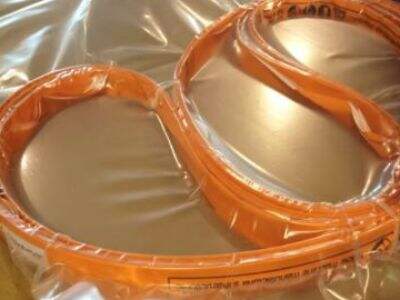Blades Are Everything When cutting stainless steel with a band saw, the choice of blade is extremely important. One thing to take into consideration is the TPI, or teeth per inch. TPI is similar to the teeth of a comb – you will get a smoother cut if you have more teeth. But how do we decide what the best TPI for cutting stainless steel is? Let's explore!
Working With Material Hardness and Choosing the Right TPI
The hard or softness of the material will be of importance when deciding on the right TPI for your band saw blade. Stainless steel is hard, so for clean cut you need a blade with a higher TPI. If the TPI is too low, the blade will bind or skip and result in a messy cut. If the TPI is too high, the blade will wear out quickly and require frequent replacement. {This is a TB rd with 12 TPI on M42 stainless. The trick to work hard AND tough cold steel is not to run fast, so not necessary to much cooling is used. It's a balance that needs to be found here and let the TPI match what hardness of ss you are using.
The Effect of Feed Rate and Blade Speed on TPI
In addition to hardness, the feed rate and blade speed are also factors in cutting stainless steel. Feed rate is how fast you push the material through the blade and blade speed is how fast the blade moves. If the feed rate is excessive, or the blade speed too slow, a higher tpi blade is beneficial for cutting slower. A lower TPI might be better if the feed rate is slow or the blade speed is fast. It is all also about finding the right balance to achieve good results.
Tooth Profile and Blade Thickness: An Important factor
It's not only the TPI on its own when deciding on a band saw blade for stainless steel. The tooth profile and blade thickness are also important. Various tooth shapes — hook and raker — are designed for different cutting jobs and could change the TPI requirement. The thickness is also a factor in how well it cuts more challenging materials such as stainless steel. Considering all of this can help you choose the right band saw blade for the job.
Balancing between cutting performance and blade life
When it comes to the best TPI for cutting stainless steel, one has to find the right tradeoff between cutting power and the lifespan of the blade. The greater the TPI, the smoother the cuts with less roughness — and the more likely a blade will wear out sooner. A lower TPI means longer life at the sacrifice of not as accurate a cut. The pros and cons of each TPI and which will work best for your cutting needs is something to consider. It’s a little bit of this and a little bit of that and you found that sweet spot between efficient cutting and a blade that’ll last for ages.
What To Look For In A TPI
There are a few key points to consider when choosing a band saw blade to cut stainless steel. Consider the hardness of the material, the feed rate and blade speed, the tooth profile and saw blade for cutting meat, and how to weigh cutting ability against blade life. With a little thought given to these variables, and selecting the correct TPI, your band saw will cut stainless steel with greater precision and ease. You will feel confident handling any cutting job and produce consistent, quality results with the proper blade from SWEAT.


